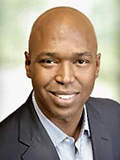Transcript
Introduction
You're listening to “Core Modernization” with KPMG, a banking podcast series dedicated to helping banks become future ready with digital transformation strategies that work and executions that deliver.
Luther Klein
Hello, and thank you for joining the latest in KPMG's banking core modernization series. Today, we'll turn our focus to the fast-changing world of consumer lending. My name is Luther Klein and I'm a partner within KPMG's FSS practice, where I have responsibility for the financial services, lending and analytics, speed of services and solutions.
For today's conversation, I'm joined by two fellow KPMG leaders, Managing Director and lending lead, Daryl Grant, and partner or our FS risk compliance and ESG lead, Todd Semanco. These gentlemen focus on the critical dimensions of our overall consumer banking transformation agenda, enabling new customer experiences, new operating models, new technologies, as well as the key dimensions of the regulatory environment. So Daryl, I'd like to begin with you. As we discuss, banks need to better integrate their customer buying experience into their lending capabilities, but getting there can be hard. What are you seeing consumer banks do today, and what are some of the broader objectives that you're hearing that need to be considered?
Daryl Grant
Sure. Thanks, Luther, for that question. And as you know, we've seen a tremendous uptick in the number of client conversations with lenders who are working to better understand how they should think about both the opportunities and the threats that are emanating from changing bar expectations, as well as new competitive threats. Now, in terms of what we're telling our clients, if I have to bullet down to a single aspirational statement, I'd say that we're encouraging and supporting our lending clients to design what I like to call future-proof lending business models that are able to sense and dynamically flex to align the change client experience expectations while seamlessly bridging their physical and digital delivery channels. We know from our research that there are a number of critical capabilities that can collectively allow lenders to deploy a business model that's designed to adapt and to be responsive to new customer experience demands, not just as discrete projects but rather by building the competence to be immediately responsive to evolving needs.
There are eight capabilities that I found to be consistently important as lenders reimagine their consumer lending business models. And don't worry, I'll spare an exhaustive rundown of all of them. But let me just mention a couple here that I believe are particularly relevant to your question. First, leading lending organizations are taking an experience-led design approach that looks at delivery through the lens of what a customer is looking to accomplish and how that customer sentiments change throughout that journey, as opposed to designing around a specific lending product. So for example, as a lender instead of asking yourself how you can increase the number of direct auto loan applications, or the pull-through of those applications; instead, you could ask, how would I support my customer in identifying, negotiating, acquiring, and maintaining the new vehicle? So essentially expanding your purview to the entire auto ownership journey. And it's this type of thinking and approach that typically leads to product and service experiences that resonate and drive deeper client connections.
The second capability that's been a major focus area for our consumer lending clients is building what KPMG refers to as data-driven flywheels. And in a nutshell, this is all about mass mastering the use of data, such that you're collecting voice of the customer and performance data, you're generating useful insights from that data, you're leveraging those insights to drive greater personalization, and then you're continuing that data collection process and a virtuous cycle of continuous innovation of the product and service experiences that you're delivering to the market. Now, while I think is a simple concept to understand, clearly building the data analytics competency, modernizing core platforms and addressing the organizational design changes that are necessary in some cases to execute on this concept are all definite challenges that our clients are facing.
Luther Klein
Daryl, I think what you highlighted there was really interesting across a number of different levels. Number one, we're seeing banks who lead with customer and experience-centric operating models get rewarded as they outperform the traditional model. In fact, our research indicates that over the last three years, these firms have generated 25% higher revenue growth and as well as 31% higher EBIDA. Number two, as a result, many of the banks that we work with are trying to rethink their capabilities in these areas. They're trying to respond and better align to customer expectations around how they interact from a relationship perspective, what are those customer values, and how do they drive and support the demand for personalization. And ultimately, this is creating greater competition and driving modernization investments across consumer lending. In fact, we believe in the next two to three years will be rapid years of change and investment in the consumer lending environment.
So Daryl, as we think about these investments, how are our clients exploring new delivery and solution models that are tied to the new product and services experience expectations of their customers?
Daryl Grant
Yeah, good question, and as you might imagine, it really does depend on where they are from a competence and capability perspective today. But what I'll tell you is that there are a number of foundational capabilities that will underpin a lender's ability to deliver new products and service experiences. Again, in an environment where consumer demands are continuously evolving, I'd say that clearly one of those foundational capabilities is enablement of a digital-first credit origination experience that allows bars to complete application intake through fulfillment, without the need for any human interaction. And I might go as far as to say that mobile-first credit origination experiences will become the predominant channel to really optimize around.
Another foundational capability for positioning your delivery model for sustainable growth is having what we refer to as Customer 360. This is obviously a part of the data mastery concept, as I mentioned earlier, and Customer 360 is nothing new to our clients, but I'd say that it's perhaps more important than ever when we're working to reduce analytical insights that allow for higher and higher degrees of personalization, and how we attract and interact with borrowers. And then the last foundational capability I mentioned is an advanced underwriting capability that promotes a high percentage of automated underwriting, across the consumer lending products, with the ability to leverage both nontraditional internal and external data inputs. Now, I know this is an area Luther you know exceptionally well, so I'll stop there because I know there's a lot more you can say on this topic.
Luther Klein
Really appreciate it, Daryl. And I think what's interesting is that we've evolved from a capability perspective, with the evolution of cloud-based technology solutions and the ability to use analytics and the zettabytes of alternative data. We're seeing banks successfully increase their adoption of automated underwriting across all consumer products. Historically, institutions had dozens of decentralized mainframe platforms that typically represented 30 to 50% of the bank's overall technology spend. And through centralizing these capabilities across a common integrated agenda, and enabling a modern product and service strategy, we've delivered up to 20 to 40% reduction in costs, while increasing the portfolio growth and margins of the consumer bank.
Now, although the value of these investments is clear, one of the challenges we consistently see is the orchestration and integration of compliance and governance requirements is a challenge. So let me turn to Todd, and what changes or best practices are you seeing to enable these solutions from a risk and compliance perspective?
Todd Semanco
Well, thanks, Luther. I appreciate that question. First off, we're seeing risk and compliance teams engaged much more upfront in the development cycle, often playing an input and challenge role as early as the technology and vendor selection process. Then we're seeing them being embedded throughout the project across all of the major pillars. For example, requirement setting, design work testing, the defect vetting, as well as through go-live. And we're also seeing a much greater adoption of agile methodology by these two compliance shops, really helping to craft and tailor epics and user stories hand in hand with the business while ensuring the regulatory requirements are identified, mapped and addressed. So really a transformation in terms of how compliance interacts with the business. And we're also seeing the actual testing processes transform as well. So beyond SIT and UAT for example, to include what I would consider compliance-focused UAT, which is really centered on the outcomes, and a lot of the end-to-end scenario permutations. And it's really what the regulators are looking for at this point in terms of that escalating bar.
Luther Klein
Todd, I think your points on integrating the governance of risk and compliance into the workflow and the major pillars of the program are critical. In fact, we are seeing this play out with a heightened regulatory expectations and exams across the lending life cycle with greater focus and bank decisioning, the use of data and key enablers like AI and ML. As a result, the failure to keep a strategic eye on really the fundamentals of risk management and regulatory compliance can have dire effects.
So as you think about the next evolution of consumer lending modernization, what trends are you seeing in risk and compliance relative to these heightened and emerging regulatory expectations?
Todd Semanco
Well, there's certainly a number of drivers at play in these initiatives and chief amongst those are related to consumer fairness and protection. There's much more focus on reducing customer confusion when designing not only the interfaces, the disclosures and the channels, but also the digital products and services themselves. So your clients thinking much more intentionally about vulnerable populations, for example, limited English proficiency, and ensuring all of the jurisdictional requirements are accounted for fully. Additionally, from a governance perspective making sure that all of the risk dimensions, so compliance and beyond, are integrated across other key operational risks such as fraud, pricing, and decisioning, just to name a few. And really the stakes are quite high. The regulators, boards, and consumers are increasingly expecting more, not only rigorous, but well-defined design and challenge activities throughout the entire development cycle.
Luther Klein
Piggybacking on what you were saying, Todd, with respect to the integration of the regulatory agenda into both requirements and the governance model, one of the areas that I see this being integrated quite a bit is in the operating and execution model around automated decisioning, and having solutions that can integrate the orchestration, execution, and governance of models, strategies, data, and workflows to enable that multiple sub-second customer lifecycle decision. So effectively, we've had this capability and card for years and really evolve into captive auto lending, but I'm starting to see leading institutions really expanding this across their personal loan business, their auto business, small business, operations and really increasing across each of these lines, automated decisioning to levels really north of 90%.
Todd Semanco
Luther, that's a really great point. As we know, our line of business execs are continuously looking for efficiency and efficacy plays, and enhanced automated decisioning, as well as automated and straight through processing, really as key levers for many. And while the upside is still there, those risks need to be managed very carefully. The regulators including the CFPB are keenly focused on those model inputs and the logic aiming to understand how perhaps unconscious bias, racial bias for example, and other potential disparate impacts are really being challenged, and then ultimately mitigated both from a build and validation perspective. Additionally, whether focused on fair lending, truth in savings, truth in lending, or unfair decepts or abusive acts or practices, the CFPB and others will want to understand how the more granular, atomic components are managed, as well as how does all of it come together from a comprehensive top down oversight capability. So really now more than ever our banks need those tools and can capabilities to align their regulatory frameworks within their overall decisioning methodologies.
Luther Klein
Thanks, Todd. And I think what you're starting to see is this intersection of risk regulation and really your compliance frameworks, and the ability to meet this digital first agenda that organizations are really aspiring to achieve.
So Daryl, I'd like to come back to you for my last question. What guidance would you give a consumer lending client who wants to better understand how they begin a consumer lending transformation agenda? And what are some of the most important factors to consider for success?
Daryl Grant
Sure, Luther. I'll start by saying you have to forgive me for a classic consulting response of, “It depends here,” but the reality is that there's what I consider an ideal approach whereby we begin with a deep outside-in business strategy analysis that looks at where and how we want to compete in terms of markets, customer personas, and value propositions, how those translating the product and service experiences, and partners which sets the vision for an operating model analysis that designs the people process, and IT capabilities needed to execute on that vision. That would be a classic approach. But that said, I think you and I both are seeing more and more of our clients taking what I'll call a more tactical approach to driving change within their consumer lending business models. We help clients to define and execute pilot programs or pilot opportunities that typically center around a specific new experience, whether it's hot topics like, buy now pay later, for example, or specific new capabilities like increasing the percentage of automated underwriting for a certain customer segment.
The benefit of this approach, this more tactical approach is that we're able to create momentum for a broader transformation effort, with the ability to self-fund through these pilots that allow us to demonstrate the value; they allow us to build organizational alignment around new ways of working; and then they allow us to promote and continue an investment from there. So I'd say that is the model that we're really helping our clients with more and more in the current environment.
Luther Klein
Daryl, I think what you just said was really critical, because more and more, I know from my experience, that program success is really built on enabling the value and sustaining the momentum throughout the journey. Let's face it, these digital change programs can be two, even three, even four year agendas at some of our clients. And at many of our clients, you can fund a sizable amount of the program from the technology and data model modernization, but to sustain the business, you need to excite the senior leadership with new products and services, and demonstrating the ability to deliver, utilizing the new modern agile methods. So as a result, for projects that really drive the most success, we focus on organizing deployments every few months so we can continually improve the RM or relationship management experience and drive bottom line value for leadership to fund future deployments of these large scale change programs.
With that said, before I get off this topic, Todd, are there any other areas or any other examples from a risk and reg perspective that you were seeing as value-led levers for this program?
Todd Semanco
Absolutely, Luther, and it's a really great question. One, that frankly doesn't get typically enough attention and to comment about exciting executives, nothing's going to excite the team more than letting them know their risk and compliance burden is going to be lesser moving forward. So to your specific question here, executives would be remiss not to account for the lift that can and should be gained and managing risk and compliance is part of the overall business case. As you think about how the end-to-end process is being redesigned, that data being digitized even further, these initiatives really allow for a great opportunity to optimize highly manual legacy risk and compliance processes, to automate several of the key compliance activities. We think about including QA/QC, testing and monitoring some of the KRI/KPI work, all of which enable better and earlier prevention and detection. So the enterprise can maximize that ROI beyond just the product delivery, and the client experience agendas, and the alignment of the governance models, strategies and compliance is really foundational to the success of these programs. And when done correctly, should yield a significant lower operating cost as well.
Luther Klein
Todd, thanks so much because I think it's helpful not only to see the business components of change, but also the risk and regulatory components that can really drive value across your consumer lending transformation strategy. Now over this conversation, I think we've heard a number of different topics, but I'm going to leave you with four key components as we see as the value-led consumer lending transformation journey. One is driving the digital-first experience. Two, the criticality of enabling a true Customer 360. Three, expanding your automated decisioning capabilities. And lastly, each of these enable the automated underwriting and servicing demands of the modern consumer customer and bank.
At this point, I want to thank you for listening to KPMG's podcast on consumer lending and invite you to listen to the next in KPMG's banking core modernization series.
Closing
Thanks for listening to this episode of Core Modernization with KPMG. We look forward to future episodes where we'll dive deeper into the core infrastructure.



